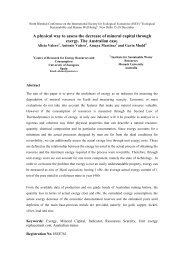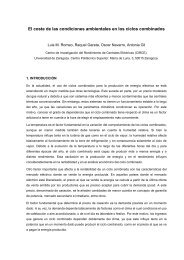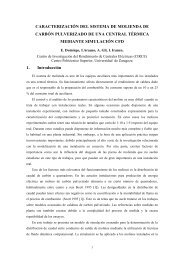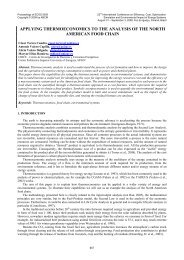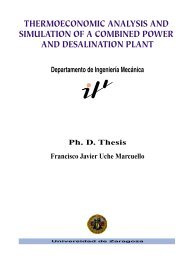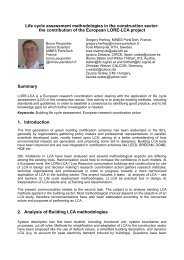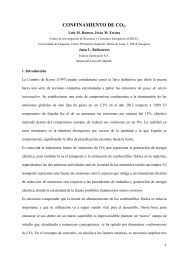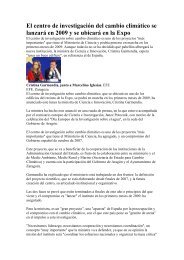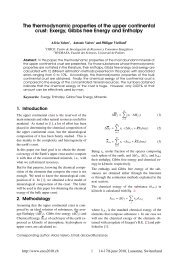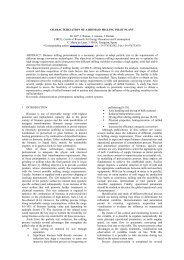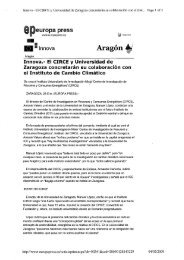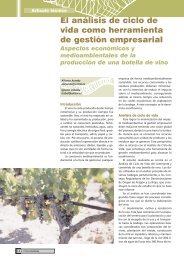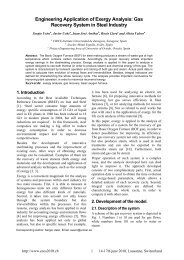flicker compliance testing for an electrical power standard ... - circe
flicker compliance testing for an electrical power standard ... - circe
flicker compliance testing for an electrical power standard ... - circe
Create successful ePaper yourself
Turn your PDF publications into a flip-book with our unique Google optimized e-Paper software.
FLICKER COMPLIANCE TESTING FOR AN ELECTRICAL POWER<br />
STANDARD ACCORDING TO THE IEC 61000-4-15:2010 AND THE<br />
IEC 61000-3-3:2008 IMPLEMENTATIONS<br />
J. Bruna, J. M. Castell, D. Cervero, M. A. García, J. J. Melero<br />
Abstract<br />
Cet article présente une méthode d’essais de con<strong>for</strong>mité<br />
de Flicker pour l’évaluation d’un étalon de référence. La<br />
méthode utilise un générateur de <strong>flicker</strong> développé basé<br />
sur des semi-conducteurs de puiss<strong>an</strong>ce discrets. On<br />
comparera avec précision les valeurs de Pst, fréquence et<br />
variations de tension pour assurer le comportement d<strong>an</strong>s la<br />
génération du générateur de Flicker. Un Flickermètre<br />
numérique a été utilisé pour obtenir les résultats du<br />
paramètre de Flicker le plus caractéristique, Pst.<br />
Avec cette approche, il est possible d'évaluer la<br />
per<strong>for</strong>m<strong>an</strong>ce d’un étalon générateur de Flicker en<br />
cohérence avec la dernière édition de la IEC norme<br />
st<strong>an</strong>dard pour essai du <strong>flicker</strong>mètre.<br />
This paper presents a <strong>flicker</strong> <strong>compli<strong>an</strong>ce</strong> <strong>testing</strong> method<br />
useful <strong>for</strong> the evaluation of <strong>electrical</strong> <strong>power</strong> st<strong>an</strong>dards.<br />
The method uses a very precise self-developed <strong>flicker</strong><br />
generator based on discrete <strong>power</strong> semiconductors. Pst,<br />
frequency <strong>an</strong>d voltage variations c<strong>an</strong> be accurately<br />
compared to assess the per<strong>for</strong>m<strong>an</strong>ce of <strong>flicker</strong> generators.<br />
A digital <strong>flicker</strong>meter has also been developed <strong>an</strong>d it is<br />
used to obtain the results of the most characteristic <strong>flicker</strong><br />
parameter, Pst.<br />
With this approach, it is possible to assess the<br />
per<strong>for</strong>m<strong>an</strong>ce of <strong>flicker</strong> generator st<strong>an</strong>dards in consistency<br />
with the latest IEC <strong>flicker</strong>meter <strong>testing</strong> st<strong>an</strong>dard edition.<br />
I. Introduction<br />
Despite the fact that <strong>flicker</strong> phenomenon does not<br />
commonly cause sensitive problems to the devices<br />
connected to the grid, this disturb<strong>an</strong>ce is getting more<br />
import<strong>an</strong>t <strong>for</strong> TSOs because <strong>flicker</strong>ing lights c<strong>an</strong> <strong>an</strong>noy<br />
end users. Cyclic connection <strong>an</strong>d disconnection of large<br />
loads causing <strong>flicker</strong> emissions are usually difficult to be<br />
minimized. There<strong>for</strong>e, <strong>flicker</strong> emissions <strong>an</strong>d hence their<br />
associated voltage variations must be tracked <strong>for</strong> avoiding<br />
health problems or device malfunction.<br />
Flickermeters must be designed following the st<strong>an</strong>dards<br />
that describe the steps to be per<strong>for</strong>med with the voltage<br />
wave<strong>for</strong>m in order to obtain the <strong>flicker</strong> parameters, Pst <strong>an</strong>d<br />
Plt. This is the only way to obtain precise <strong>an</strong>d reliable<br />
measurements. A digital <strong>flicker</strong>meter based on the current<br />
st<strong>an</strong>dards [1,2] has been developed <strong>an</strong>d it has been used<br />
<strong>for</strong> assessing the per<strong>for</strong>m<strong>an</strong>ce of <strong>an</strong> <strong>electrical</strong> <strong>power</strong><br />
st<strong>an</strong>dard (Fluke 6100A). The results have been compared<br />
with those obtained with a semi-ideal <strong>flicker</strong> generator<br />
constructed with discrete <strong>power</strong> semiconductors.<br />
The <strong>flicker</strong>meter fulfils all the tests presented in the latest<br />
st<strong>an</strong>dards, ensuring the validity of the measurements with<br />
CIRCE – University of Zaragoza, Zaragoza, Spain<br />
jbruna@unizar.es / melero@unizar.es<br />
very low measurement uncertainties. The developed<br />
<strong>flicker</strong> generator, based on a static commutation system,<br />
also meets the requirements <strong>for</strong> high-end <strong>power</strong> quality<br />
st<strong>an</strong>dards.<br />
The comparison between the Pst readings of the two<br />
generation methods will demonstrate the validity <strong>an</strong>d<br />
accuracy of the Fluke’s <strong>flicker</strong> module <strong>for</strong> the newer<br />
version of the IEC 61000:4-15 st<strong>an</strong>dard.<br />
Summarizing, this paper shows preliminary results <strong>for</strong> the<br />
evaluation of <strong>flicker</strong> measurements by their deviations <strong>an</strong>d<br />
uncertainties. The comparison of both methods has been<br />
assessed using the criteria of the guideline ILAC G-<br />
13:2007 expressing the results using En numbers [3] as<br />
well as plots of repeatability st<strong>an</strong>dard deviation defined<br />
under the ISO 13528:2005 st<strong>an</strong>dard [4].<br />
II. Instrumentation<br />
The per<strong>for</strong>m<strong>an</strong>ce of the <strong>electrical</strong> <strong>power</strong> st<strong>an</strong>dard <strong>for</strong><br />
<strong>flicker</strong> generation will be assessed through the comparison<br />
of the Fluke 6100A <strong>flicker</strong> output <strong>an</strong>d the own-developed<br />
system with a high-end digital <strong>flicker</strong>meter. The most<br />
relev<strong>an</strong>t characteristics of these three devices will be<br />
briefly described next.<br />
Flicker Generator<br />
The system was designed according to the scheme shown<br />
in Figure 1.<br />
R1<br />
+<br />
Vsource<br />
-<br />
R2<br />
Q1<br />
IGBT<br />
Q2<br />
IGBT<br />
Figure 1. Flicker generator scheme<br />
An Omicron CMC 256 unit is used as a precise voltage<br />
source. Its flexibility provides the necessary accuracy (ε <<br />
0.015% rd. + 0.005% rg.) <strong>an</strong>d adjustable voltage output<br />
(up to 150 VA) to obtain the traditional <strong>flicker</strong> test<br />
wave<strong>for</strong>ms [1] with enough stability. For design purposes,<br />
this equipment is considered like <strong>an</strong> ideal voltage source<br />
(the current drawn depends only on the circuit to which it<br />
is connected).<br />
The <strong>flicker</strong> modulation depth is obtained by adjusting the<br />
8 W 10-turns potentiometer <strong>an</strong>d the posterior combination<br />
of two 50 W-1 kΩ resistors. The two <strong>power</strong><br />
R3
semiconductor devices (IXSP10N60B2D1) are<br />
comm<strong>an</strong>ded by a microcontroller to per<strong>for</strong>m a rect<strong>an</strong>gular<br />
switching with a 50% duty cycle. This pulse wave is<br />
digitally controlled <strong>an</strong>d calculated by a PIC<br />
microcontroller (16F84) through a 4 MHz crystal with a<br />
±30 ppm frequency toler<strong>an</strong>ce.<br />
Seven switches are used to ch<strong>an</strong>ge the modulation<br />
frequency expressed in Ch<strong>an</strong>ges Per Minute (1CPM,<br />
2CPM, 7CPM, 39CPM, 110CPM, 1620CPM <strong>an</strong>d<br />
4000CPM). A blinking LED mounted on the aluminum<br />
enclosure is used to indicate the signal output.<br />
All the tests were per<strong>for</strong>med using 120 V <strong>an</strong>d 50 Hz as<br />
nominal values. The nominal frequency was chosen the<br />
same as the Europe<strong>an</strong> grid frequency while the 120 V<br />
nominal voltage value was selected due to design<br />
restrictions related with the resistor <strong>power</strong> ratings <strong>an</strong>d the<br />
output <strong>power</strong> limit of the used voltage source.<br />
Figure 2 shows a block diagram of the developed system.<br />
Ideal<br />
Voltage<br />
Source<br />
MCLR<br />
VDD,VSS<br />
IGBT<br />
Power<br />
Semiconductor<br />
2<br />
C<br />
16F84A<br />
7<br />
Flicker Frequency<br />
Switch<br />
Imped<strong>an</strong>ce<br />
Network<br />
Flickermeter<br />
OSC<br />
LED<br />
Figure 2. Block diagram of the Flicker generator<br />
Electrical Power St<strong>an</strong>dard<br />
The Fluke 6100A is a Power Quality St<strong>an</strong>dard used <strong>for</strong><br />
calibrating <strong>power</strong> quality measurement tools to meet the<br />
dem<strong>an</strong>ds of the <strong>electrical</strong> market. This equipment<br />
simulates <strong>flicker</strong> by amplitude modulating the voltage<br />
with depth <strong>an</strong>d modulation frequency set by the user. It<br />
c<strong>an</strong> supply <strong>an</strong>y <strong>flicker</strong> level up to ±30% of the set voltage<br />
within r<strong>an</strong>ge values (60% of ΔV/V). Its flexibility allows<br />
the user to get <strong>flicker</strong> wave<strong>for</strong>ms <strong>for</strong> 120 V <strong>an</strong>d 230 V at<br />
50 Hz <strong>an</strong>d 60 Hz combinations.<br />
The interface is accessed through a combination of front<br />
p<strong>an</strong>el buttons, a mousse <strong>an</strong>d a keyboard. Status<br />
in<strong>for</strong>mation of whole system <strong>an</strong>d current adjusted <strong>power</strong><br />
quality parameters are showed on the display.<br />
Digital <strong>flicker</strong>meter<br />
The <strong>flicker</strong>meter architecture was developed following the<br />
latest st<strong>an</strong>dard <strong>for</strong> the design of <strong>flicker</strong>meters [1].<br />
This equipment has been accurately characterized <strong>for</strong> the<br />
design nominal values, 120 V/50 Hz. The selected<br />
sampling rate <strong>for</strong> the digital filters <strong>an</strong>d overall statistical<br />
evaluation was 36 kS/s. For the evaluation in Block 5<br />
(classifier), 20000 classes were used to obtain the best<br />
approach <strong>for</strong> all the tests.<br />
The equipment meets all the requirements of the current<br />
st<strong>an</strong>dard [1] with deviations lower th<strong>an</strong> 0.1% from ideal<br />
Pst values. With these results, the <strong>flicker</strong>meter c<strong>an</strong> be<br />
labeled as a Class-A1 instrument <strong>for</strong> precise <strong>an</strong>d accurate<br />
<strong>flicker</strong> measurements.<br />
III. Characterization<br />
In order to characterize the developed <strong>flicker</strong> generator,<br />
voltage variations (ΔV/V) <strong>an</strong>d rect<strong>an</strong>gular modulating<br />
frequency were separately assessed. Stability tests were<br />
also per<strong>for</strong>med <strong>for</strong> the equipment.<br />
Modulating Depth<br />
A calibrated Fluke 8508A DMM (best uncertainty equals<br />
to 90 µV/V rd. + 10 µV/V rg.) was used to measure the<br />
voltage between high <strong>an</strong>d low states of the rect<strong>an</strong>gular<br />
modulation. All voltage measurements <strong>for</strong> the different<br />
tests were made at 1CPM to stabilize the value <strong>for</strong> being<br />
accurately measured by the DMM. No voltage deviations<br />
were detected when ch<strong>an</strong>ging the modulating frequency.<br />
The overall uncertainty was calculated according to the<br />
Guide to the Expression of Uncertainty in Measurement<br />
[5] taking into account the resolution of the DMM digital<br />
indication, the measurement repeatability <strong>an</strong>d the<br />
specifications of the measuring instrument.<br />
The obtained results are shown in Table 1.<br />
Table 1. Voltage variation calibration results<br />
St<strong>an</strong>dard [1] Flicker generator<br />
CPM ΔV/V (%) ΔV/V (%)<br />
Uncertainty<br />
(ΔV/V) (%)<br />
1 3.178 3.178 ±0.018<br />
2 2.561 2.563 ±0.018<br />
7 1.694 1.694 ±0.018<br />
39 1.045 1.044 ±0.018<br />
110 0.844 0.843 ±0.018<br />
1620 0.545 0.548 ±0.018<br />
4000 3.426 3.426 ±0.018<br />
Note that the overall <strong>flicker</strong> modulation depth accuracy of<br />
the Fluke 6100A is ±0.025%, comparable to the<br />
uncertainty levels shown in Table 1.<br />
Modulating Frequency<br />
The second magnitude that defines a Pst value is the<br />
modulating frequency value. To characterize this<br />
parameter, a frequency measurement at the IGBT input<br />
gate was made. Due to the high switching frequency of the<br />
IXSP10N60B2D1 (up to 20 kHz), the slew rate effect of<br />
the tr<strong>an</strong>sistors in the tr<strong>an</strong>sitions c<strong>an</strong> be neglected so the<br />
output signal exactly matches with the modulation of the<br />
<strong>flicker</strong> voltage wave<strong>for</strong>m. An Agilent 53131A digital<br />
counter connected between emitter <strong>an</strong>d gate terminals was<br />
used <strong>for</strong> this purpose.
The frequency calibration results are shown in Table 2.<br />
CPM<br />
Table 2. Frequency calibration results<br />
St<strong>an</strong>dard [1] Flicker generator<br />
Frequency<br />
(µHz)<br />
Deviation<br />
(µHz)<br />
Uncertainty<br />
(µHz/Hz)<br />
1 8333.3 -0.4 ±8.6<br />
2 16666.7 -0.7 ±8.6<br />
7 58333.3 -5.5 ±8.6<br />
39 325000.0 -111.1 ±8.6<br />
110 916666.7 -798.9 ±8.6<br />
1620 13500000.0 -12828.4 ±8.7<br />
4000 33333333.3 6312.9 ±8.6<br />
With the results of previous table, a comparison between<br />
the per<strong>for</strong>m<strong>an</strong>ce of the Power St<strong>an</strong>dard Fluke 6100A <strong>an</strong>d<br />
the <strong>flicker</strong> generator in terms of rect<strong>an</strong>gular modulating<br />
frequency accuracy c<strong>an</strong> be represented.<br />
Deviation + uncertainty (Hz/Hz )<br />
1400<br />
1200<br />
1000<br />
800<br />
600<br />
400<br />
200<br />
0<br />
Stability<br />
Flicker generator<br />
Fluke 6100A<br />
1 10 100 1000 10000<br />
Ch<strong>an</strong>ges per minute (CPM)<br />
Figure 3. Modulating frequency comparison<br />
Stability per<strong>for</strong>m<strong>an</strong>ce of the developed <strong>flicker</strong> generator<br />
has been studied <strong>an</strong>d the results are shown in Figure 4.<br />
This test was used to check the system <strong>an</strong>d so its Pst<br />
stability along the time. 400 Pst values were recorded <strong>for</strong><br />
1620 CPM <strong>an</strong>d 0.545 % (ΔV/V) being relatively const<strong>an</strong>t<br />
in the studied interval (Pst = 0.9999 ± 0.0022). The inset in<br />
Figure 4 shows a detailed view of the Pst evolution during<br />
2 hours.<br />
Pst<br />
1.06<br />
1.04<br />
1.02<br />
1.00<br />
0.98<br />
0.96<br />
0.94<br />
0.99800<br />
0.99775<br />
0.99750<br />
Pst reading<br />
IEC st<strong>an</strong>dard limits<br />
205 210 215 220 225<br />
50 100 150 200<br />
Data<br />
250 300 350<br />
Figure 4. Generation stability test<br />
IV. Results of the comparison<br />
Seven modulating frequency points were chosen <strong>for</strong><br />
assessing <strong>flicker</strong> generation. Modulation voltage depth<br />
was selected according to the current st<strong>an</strong>dard [1] <strong>for</strong><br />
obtaining Pst values equal to 1. These wave<strong>for</strong>ms were<br />
generated with one UKAS certified Fluke 6100A <strong>an</strong>d later<br />
with the developed <strong>flicker</strong> generator. Both outputs were<br />
recorded <strong>an</strong>d <strong>an</strong>alysed with the A1-class digital<br />
<strong>flicker</strong>meter. Pst readings from the two <strong>flicker</strong> generators<br />
were <strong>an</strong>alytically <strong>an</strong>d graphically compared using error<br />
bars <strong>an</strong>d En numbers [3].<br />
Several error bars corresponding to the Fluke 6100A <strong>an</strong>d<br />
the own-developed <strong>flicker</strong> generator are represented in the<br />
Figure 6. It is clear that the results concerned to Fluke<br />
6100A completely overlap the Pst readings from the owndeveloped<br />
generator.<br />
Pst<br />
1.003<br />
1.002<br />
1.001<br />
1.000<br />
0.999<br />
0.998<br />
0.997<br />
Figure 6. Pst comparative. Fluke 6100A vs <strong>flicker</strong> generator<br />
The results c<strong>an</strong> also be compared by using the tools<br />
applied in interlaboratory comparison, the En numbers [4].<br />
They are calculated with the assigned value determined in<br />
a reference laboratory (X), the exp<strong>an</strong>ded uncertainty of X<br />
(Uref) <strong>an</strong>d the exp<strong>an</strong>ded uncertainty of a laboratory’s result<br />
x (Ulab) according to the following <strong>for</strong>mula:<br />
<br />
Ch<strong>an</strong>ges per minute (CPM)<br />
<br />
<br />
When the exp<strong>an</strong>ded uncertainties are calculated using a<br />
coverage factor of 2.0, the critical value <strong>for</strong> <strong>an</strong> En number<br />
is 1.0. En per<strong>for</strong>m<strong>an</strong>ce levels are normally determined as<br />
follows:<br />
En
The calculated En numbers are shown in Table 3, being all<br />
of them clearly below 1.<br />
Table 3. Fluke 6100A vs developed <strong>flicker</strong> generator En<br />
CPM En numbers<br />
1 0.003<br />
2 0.001<br />
7 0.014<br />
39 0.005<br />
110 0.031<br />
1620 0.013<br />
4000 0.092<br />
V. Conclusions<br />
A semi-ideal <strong>flicker</strong> generator has been developed <strong>an</strong>d<br />
tested. The generator was constructed with <strong>an</strong> ideal<br />
voltage source <strong>an</strong>d using a commuted circuit with <strong>power</strong><br />
semiconductors. It allows obtaining voltage wave<strong>for</strong>ms<br />
with user adjustable voltage variation (ΔV/V) <strong>an</strong>d<br />
frequency modulation.<br />
The <strong>flicker</strong> generator has been characterized by measuring<br />
the voltage variation (ΔV/V) <strong>an</strong>d the modulation<br />
frequency of its output voltage wave<strong>for</strong>m. The values<br />
obtained <strong>for</strong> both parameters were of the same order of<br />
magnitude that those given in the specifications of the<br />
Fluke 6100A. The generator stability was also tested by<br />
<strong>an</strong>alysing 400 Pst measured values obtained with a<br />
modulation frequency of 1620CPM. The obtained Pst<br />
values clearly fulfilled the requirements of the current IEC<br />
st<strong>an</strong>dard.<br />
A digital Class-A1 <strong>flicker</strong>meter has been developed. The<br />
equipment meets all the requirements of the current<br />
st<strong>an</strong>dard with deviations lower th<strong>an</strong> 0.1% from ideal Pst<br />
values.<br />
Finally, the self-made <strong>flicker</strong> generator <strong>an</strong>d the Power<br />
St<strong>an</strong>dard Fluke 6100A have been compared using the Pst<br />
measured at their outputs. The comparison has been<br />
per<strong>for</strong>med in two ways, with <strong>an</strong> error-bar graph <strong>an</strong>d with<br />
the En numbers. The obtained results allow concluding<br />
that the Fluke 6100A Power St<strong>an</strong>dard complies with the<br />
requirements of the IEC 61000-4-15 St<strong>an</strong>dard.<br />
VI. References<br />
[1] IEC 61000-4-15 ed2.0, "Part 4: Testing <strong>an</strong>d<br />
Measurement Techniques - Section 15:<br />
Flickermeter - Functional <strong>an</strong>d Design<br />
Specifications", 2010.<br />
[2] IEC 61000-4-15 ed1.1, "Part 4: Testing <strong>an</strong>d<br />
Measurement Techniques - Section 15:<br />
Flickermeter - Functional <strong>an</strong>d Design<br />
Specifications", 2003.<br />
[3] "ILAC G-13: Guidelines <strong>for</strong> the Requirements <strong>for</strong><br />
the Competence of Providers of Proficiency<br />
Testing Schemes", International Laboratory<br />
Accreditation Cooperation, 2007.<br />
[4] "ISO 13528: Statistical Methods <strong>for</strong> Use in<br />
Proficiency Testing by Interlaboratory<br />
Comparisons", International Org<strong>an</strong>ization <strong>for</strong><br />
St<strong>an</strong>darization, 2005.<br />
[5] JCGM 100:2008, "Evaluation of Measurement<br />
Data - Guide to the Expression of Uncertainty in<br />
Measurement", 2008.



